Pioneer Trail

Mabukuwene Nature Reserve Fridays 19:00 - 21:00 hrs http://matabele.altervista.org/troops | Norman Scott Norman's Email address |
With thanks to:- Editor - Norman Scott
Distributor: Rowan Francis
The past year has presented us in Zimbabwe with many challenges in all spheres of life. The
prevailing conditions that we are living under have not been conducive in the upbringing of our
children in a normal democratic society, where there should be a clear distinction between right
and wrong, fair and unjust. Where it has been a question of self preservation, many evasive
tactics have had to be resorted to in making a living, just to feed and clothe a family and send
them to school. The huge disparity between costs of services and commodities which soared to
unprecedented levels verses earnings coupled with the uncertain political arena did little to instil
confidence in the population in general.
As far is the Troop is concerned, I would like to thank you Scouts and you, the parents, for
continuing to keep our scouting active by attending all activities that were offered, both at Troop
level and what was offered by our Provincial Leadership. It is our duty as Leaders in Scouting to
provide for the long term development of the young men in our care, in order that they receive a
balanced life system that will benefit them in their adulthood. However, amidst our harsh and
depressing environment, there is an abundance of positive aspects, which, when recognised and
utilised to good effect, provide the stimulus to carry on. I need not elaborate on this, as you will
have the opportunity of reading the accounts of these activities, written by the Scouts themselves,
in the pages that follow.
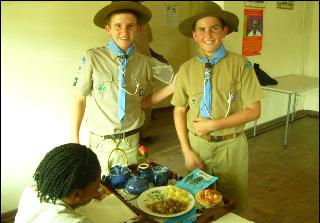 Brendan and Declan present their meal for judging |
In dealing with the events of the previous four month's
since Pioneer Trail was last published, the Troop has been
very active. Our programme of activities set out at the
beginning of September until now, was achieved and
indeed added to. Our monthly hikes, I am convinced are
playing a vital role in the development of the boys. They
provided for the planning of their own lives, with the
assistance of parents. The experience in some instances
may have, at first been seen as an insurmountable
challenge of carrying one's own needs for the duration of
the hike and naturally of finding their own way. This last
statement can be read both literally and metaphorically.
By taking part in the activities offered, the change of attitudes over a period of time could be seen,
as the boys developed into young and responsible men. Mistakes were made and indeed they
are a vital part of the learning curve. As each is different from the other, their individual characters
interacting through the medium of the particular activity being under taken, are necessary to help
each in their development. Those who do not attend all the hiking opportunities, also play their
part in the life of the Troop, for they add another dimension to the mosaic of our Scouting. The
end result of the Scouts, with their individual characters, is that I am very proud of them all and I
see in each of them, a bright future no matter where they settle in their adult life.
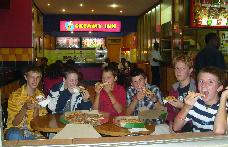 End of year pizza feast |
The annual Provincial Cook-Out competition was held at
Provincial Scout Headquarters in September. The Troop
entered two sections with Christopher MacKenzie and
Dylan Strydom in the senior section and Brendan Judge,
Declan FitzPatrick and Dillin McAtier in the under 14 year
section. Later in September, Dillin McAtier was invested
into the Troop in our campsite at Gordon Park. Welcome
into the Troop Dillin. You will find that we have a wide
range of activities that will keep you interested.
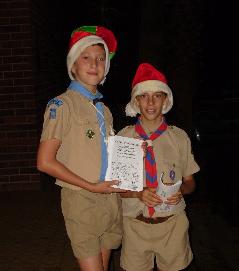 Scouts Dillin McAtier and Brendan MacKenzie (8th Hillside). in festive attire selling programmes at the Panto. |
Then
during November, Leon Wuyts a former member of the
Troop and who is now undergoing a 'gap' year in England before setting his sights on a career
paid us a visit. Besides taking part in a hike, just for old time's sake, he left us an assortment of
sweets and a box of light sticks; just what us young fellows need to keep us amused. Thank You
Leon for your gifts.
An extra item to feature on our programme was that we were
once again invited to assist with the management of the 'Front
of House' at the Bulawayo Theatre, during their production of
the Pantomime, 'Santa in Space'. The Scouts coped extremely
well in selling programmes, operating the Chocolate Box and
ushering patrons to their seats. The Pantomime was a huge
success. Congratulations to all the actors and back stage crew,
you did Bulawayo proud and you added that sparkle to
Christmas. You all proved that there is a wealth of talent, young
and not so young in Bulawayo.
The last meeting of the year, just a few days before Christmas,
was something special, for we invaded the local Pizza Parlour
and gorged on pizzas, cold drinks and ice-creams. A terrific
way to end a fun filled year of scouting. Following this, we
visited the Scouts of the 8th Hillside Troop, to wish them a
Merry Christmas.
And now it is back to my hammock beneath my favourite Pseudolachnostylis maprouneifolia with my floppy hat pulled over my eyes as I wish you a
Blessed Christmas and a Happy New Year. And in so doing I will be dreaming of the special
activities that are being planned to celebrate our Troop's One Hundredth birthday next year. So
come aboard and join with us in our celebrations.
Pseudolachnostylis maprouneifolia with my floppy hat pulled over my eyes as I wish you a
Blessed Christmas and a Happy New Year. And in so doing I will be dreaming of the special
activities that are being planned to celebrate our Troop's One Hundredth birthday next year. So
come aboard and join with us in our celebrations.
N. Scott
Scout Leader

Shentendebudzi
5th - 6th September 2008
We left as normal from Christ the King Church. Our hike party for this month's hike was, Norman
Chris, Dillin and myself (Declan). On Arriving at Gordon Park, Norman introduced us to his
relations, Mrs. Scott (who was later to be given the nickname of 'Gogo') and her son Sean. We
then unloaded everything except our hiking kit. Norman said that seeing his nephew was here, he
had changed the hike route because his nephew could take us to another point by car and then
return his Landy back to Gordon Park where we would end our hike.
Once we were ready, we got into the Landy and set off for a picnic site along the Circular Drive,
near the Hazleside Park's office, fifteen kilometres from Gordon Park. We stopped on a little dirt
track next to a small stream. Here we set up our camp and as usual Chris hurriedly made a fire to
provide some light as there was only a small moon. With Sean driving the Landy, he left leaving
us no option but to do the hike. So by the light of the campfire, we made our beds on the dirt
track, ate supper and then went to bed. I do not think anyone slept well, because it was cold -
real cold. And the only sound was the wind blowing the dust into the now burnt out fire.
We had an early start to our day due to my watch being about an hour ahead of the real time.
Having had our breakfast, Norman said that we would be going to see a natural wall made of
stone about three kilometres to the west of where we were and then we would come back
through this point on our way to Gordon Park. As we were to come back to this point, we hid our
packs in a small kopje and left following an animal trail through the dry grass.
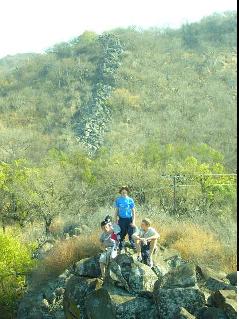 Standing on "The Natural Wall" |
It only took us about forty-five minutes to reach our intended
destination. Having climbed a little way up a small kopje, Norman
told us to look behind us. We turned and there stretching out in
front of us, (we were standing on it), was the 'wall' going in a
straight line up the kopje on the other side of the valley. We
turned around again and then we saw it, continuing up the kopje
we were on, in a straight line to the top. It was cool. Norman
explained that the 'wall' was a dolerite dyke. Dolerite is a
greenish black finely crystalline rock closely related to basalt
lava, though in this form it never reached the surface. Dolerite is
much later in age that the granite and not related to it. In its
molten form it was pushed up into the cracks that had developed
in the cooling granite and so formed the dyke. In turn this rock
solidified and also cracked on cooling. Today we see this dyke as
a wall of huge blocks of dolerite.
Having had a rest we started on our way back to our campsite,
but Norm's remembered that we had not taken any pictures, so
we retraced our steps up the dyke to get photies. Back at ground level, Norman took us off to one
side of the track and showed us a small stone. It looked like the torso of a small man. This
'sculpture' Norman told us, was the 'Shentendebudzi' that in days past, the local people would
leave some gift at its base in order to get safe passage through the dyke. The name
'Shentendebudzi' is Chikaranga and seems to be associated with the idea of 'turning away' or
perhaps an 'obstacle which must be gone around'. It is known as 'Mombashaba' by the Ndebele
which also means, 'That which one must go around'.
We then headed back to the place where we spent the night, collected our packs and continued
on our hike back to Gordon Park. Our route took us through thick bush, where we found the spoor
of many wild animals. We eventually found the small track that would lead us to Gordon Park. We
knew this track very well, for it is the one Norman drives his Landy along when we collect
firewood for use at Gordon Park. It was not long before we entered Gordon Park over the
waterfall behind Head Quarters. I think it was a good hike, but others have been warmer.
Declan FitzPatrick
Parent's Camp in 'The Heart Of Scouting'
6th - 7th September 2008
Saturday 6th September 2008 found us pulling up at Head Quarters, Gordon Park for the Parent's
Camp. The tranquillity and beauty of the Park as always was breathtaking. As John FitzPatrick
and his son Kevin, Ken, Sheree and I ambled over to the open plan kitchen, Norman came into
view and greeted us with a smile and stated, 'You're in time for tea'. We were introduced to
Norman's relatives, Mrs. Billie Scott and her son Sean who were visiting from South Africa.
After tea, Parents and siblings drove to the 1st Bulawayo (Pioneer) campsite in the Bowl Camping
area, where we found our home for the night. The tents were erected, beds made, food baskets
were un-packed and soon we had our meat sizzling on the braai fire. The Scouts were lively, full
of fun and jolly banter. Following dinner as dishes were being washed and dried, Norman advised
that at 7.30pm we were all to meet at the camp fire for the evening's ceremony. The boys
scattered in all directions to collect and get dressed into their Scout uniforms.
Seated round the camp fire circle in the Troop's campsite, we watched with bated breath as Dillin
Mc. lit the far end of a 'grass runway' leading to the logs of the camp fire. Slowly the flames crept
along the ground and at last into the base of the camp fire. As the neatly laid logs of the camp fire
caught alight, crackling and hissing, the flames leapt up higher and higher. John, our camp fire
Leader opened the evening with the following verse:
As the flames point up so be our aims,
As the red logs glow so be our endeavours,
As the grey ash fades so be our errors,
As the good fire warms the circle -
So may our ideals warm the World.
What a fitting verse for our young boys as they embark on their journey into life.
Soon all our faces were illuminated and glowing in the light cast by the dancing flames reaching
for the stars. John announced the first song, the first of many that were to be heard that evening.
The sound of voices and the music from John's guitar echoed in the still night air.
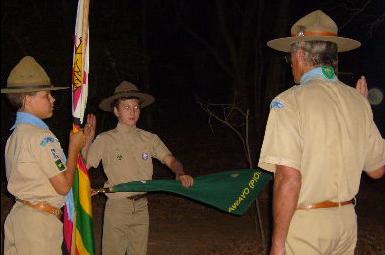 Dillin is invested into the Troop |
At some time during the camp fire, it is all a fabulous
memory now, Chris and Dale stepped forward bearing
the National and Troop flags. It was the McAtier
family's big moment, for it was time for Dillin Dwight
McAtier to be invested into the 1st Bulawayo (Pioneer)
Scout Troop. Dillin had already been invested into the
Scout movement as a Cub Scout, in the 8th Bulawayo
(Hillside) Group, but he was now transferring and was
being invested into the 1st Bulawayo Scout Troop. A
hushed silence fell over everyone as Dillin, standing
on the edge of the camp fire circle, facing in and
having had his 8th scarf removed, placed his left hand
on the Troop flag of the 1st Pioneer Troop that had been lowered in front of him.
Dillin repeated
the Scout Promise. Norman then placed the scarf of the 1st, light blue with the Pioneer Pick
emblem on the apex at the back, round Dillin's neck. The black woggle and white lanyard
contrasted against the blue. He was then given his two 1st Bulawayo shoulder emblems. Norman
proceeded to enlighten us that in times gone by, the lanyard was worn round the neck by a
soldier on horseback and the other end was attached to his pistol. In the event that the soldier let
go of his pistol for any reason, the lanyard would prevent the pistol from dropping to the ground
and getting lost. With the pistol attached to a lanyard a soldier could easily recover his pistol
whilst still riding. The final presentation made to Dillin was a booklet outlining what scouting
adventures lay ahead of him whilst a member of the 1st Pioneer Troop.
With the investiture of Dillin into the Troop over, Chris and Dale replaced their flags in their
holders at the entrance to the campsite and we continued with the singing of a few more songs
before it was time for the closing. We all stood and sang the one verse, of 'Scout Vesper' to the
tune 'Tannenbaum' and as our voices drifted and faded on the still night air and silence followed,
in a strong but quiet voice, Dillin who had surreptitiously moved some distance from the camp
fire, sang solo, the replying verse. This second verse was not printed in the songbook so it took
us all by surprise. To Ken and I, as Dillin's parents, it was a touching moment which brought tears
to our eyes. This investiture ceremony will remain in the memories of the McAtier family forever.
Following the camp fire, flap-jacks, vanilla and chocolate cake with cocoa or hot chocolate was
served in celebration. All was quiet in camp by 10.00pm.
The sound of the traditional Kudu horn being blown in camp and the, 'You have ten minutes', by
Norman woke the campsite at 5.45am on Sunday morning. The laughter of the boys filled the
camp as they prepared to climb aboard 'Ingulungundu', Norman's Land Rover and head for
Shumba Shaba. Chris, Sheree and I opted to stay in camp. With seven males aboard
'Inguluvane', they set off for the legendary Shumba kopje, which is climbed ceremoniously by all
who have the will and energy. By 8.00am everyone had returned to camp and was enjoying
breakfast.
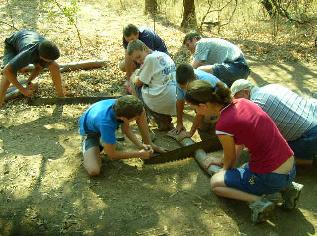 The log sawing contest |
The first activity of the day was the wood sawing
competition. Everyone took part in this, but don't
be fooled that sawing great big logs with a pitsaw
is easy. As we found out, it definitely requires a
'pull' movement and not a 'push' movement, to get
the saw to cut. The 'push' movement will have the
saw bending and jumping out of the saw cut. It
was challenging indeed!!! And who were the
winners? Well, I guess we all were for there was
so much laughter, huffing and puffing, that no one
was keeping score.
Water fight!! Who actually started this I am not
sure. But let it be known that every single
person, man, woman and Boy Scout was drenched, no mercy was shown. Indirectly, it was a
welcome relief from the morning's heat.
The breaking of camp and of transferring back to Head Quarters was quick. Eleven o'clock found
Norman and the eager young boys on the ledge of Gordon Park Rock with ropes and safety gear
on, ready for abseiling. At first the parents sat at the bottom of the rock face watching the boys
abseil down and wondering if it was advisable to take part in this activity. Then Ken, first of the
dads appeared on the ledge, harnessed and abseiled down the rock face. John followed suit,
making it look so easy and fun and then Sheree. As for Monika, well she took a lot of convincing
and encouragement from all to abseil down. Was it worth it??? Yes, it was GREAT!! Tea was
definitely in order for all.
After a light lunch, targets of tin cans were erected in the open plan outdoor kitchen area. Under
the strict supervision of John, the ever enthusiastic boys tried their luck at shooting holes in the tin
cans. Either the barrels are bent or the boys are definitely poor shots, as only three shots out of
many hit three cans.
As the late afternoon breeze blew through the trees, everyone had packed up and made ready to
go back to town. It was very enjoyable weekend indeed. Thank you Norman and Scouts for
making the parent's camp so much fun.
Monika McAtier
Parent
Golden Anniversary
Each year in September I travel for a week to the southern reaches of the Matopos to check on
the condition of the cattle and to see what preparations are being made for the coming
agricultural season. I was pleased to note that there were still a few small pools of water in the
rivers however, there was not much grazing for the cattle. Then on my way back to Gordon Park,
I was saddened to see that a number of veldt fires had ravaged through the National Park and
also into the adjacent farm lands.
On arriving back at Gordon Park early on Sunday morning, the 9th September, I was astonished
to discover that my kingdom had been transformed during my absence. I mean, who in their right
mind would erect a large tarpaulin behind the Leask. Not only this, but there were boards of
photographs, posters and other pamphlets scattered all over the veranda of the 'Stables'. Now,
what was happening in my Kingdom? After all, I had only been gone for a week and I had no
inkling, apart from the usual monthly Church Service, that any additional activity had been
scheduled for this Sunday.
I moved in closer to investigate. From my vantage point high up on Leask Rock I could look down
unobserved. I unfolded my deckchair and settled back comfortably as I sensed that this was
going to be a long and exhausting day for me. Below me was the Camp Commissioner and a
Scout busy sorting out an array of kit, from a trek cart of Scouting days past, a one man pup tent,
ruck sack, cooker and so the list of camping items goes on. In addition to these items were
leather bound logbooks of hikes, jamborees and special anniversaries covering many years of
Scouting. There were two uniform shirts on display, one with the 8th Bulawayo (Hillside) scarf the
other with the 1st Bulawayo (Pioneer) scarf. On the walls of the 'Stables' were boards of
photographs, souvenir programmes, Wolf Cub membership and Scout membership record cards.
Flags added that extra fairground atmosphere and above the Gateway to the Skipper Knapman
Training Ground and beyond to the Scout activity area and campsites, was the clue to it all. A
large 50 and the dates 1958 - 2008 had been painted on a board. Ah, things were beginning to
make sense, an anniversary. But what/ who's anniversary, and why the secrecy? After all, it is my
Kingdom and I should be consulted on all matters pertaining to anything that is planned,
celebration or not.
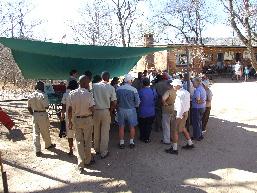 A gathering at the tarpaulin under which was the Trek-cart and album display |
As the morning progressed and people arrived for the
monthly church service, the chatter of excited voices
was much more vibrant than normal. People moved
around the displays until the peeling of the Chapel
bells had everyone scurrying to the St. George's
Chapel in amongst the granite boulders behind
Gordon Park Rock. Only then was the mystery of the
display officially revealed. It was the Camp
Commissioner's Fiftieth Anniversary in the Boy Scout
Movement. Quite coincidently, the service was
conducted by a former Scout, who is a lay minister at
Saint John's Cathedral in Bulawayo.
Following the service and to everyone's surprise, all
sixty-five people present were invited to share in a stirfry
lunch including wine or cool drinks, even though people, had as usual brought their own food
and refreshments. Then it was tea time and the moment to cut the 50h Anniversary cake, but not
before a short speech of thanks to people who had unknowingly over the past few months,
helped to make the day. Unknowingly, yes for whenever anyone goes to South Africa or to
Botswana on a shopping trip, they usually offer to bring back some essential items needed by
their friends and so 'essential' items had obviously been requested by the Camp Commissioner
for this celebration.
Of special importance the Camp Commissioner told a most unusual story filled with coincidences.
It went as follows: 'This month I celebrate my fiftieth year since I was invested into the Scout
movement in Bulawayo as a Wolf Cub. My nephew's son, Jonathan, was invested into the Scout
movement in Cape Town (South Africa) just a couple of weeks ago as a Cub Scout. Jonathan
was invested into the 1st Camps Bay Cub Scout Pack. I did not know of his intention to join the
Movement as his father had never been a Scout. On three occasions in the 1970's I used the
1st Camps Bay Scout hall as my base when taking Rhodesian Scout contingents to the South
African Senior Scout Adventures in the mountains to the north of Cape Town and my own week
long 8th Scout Troop holiday to Cape Town in 1980. Jonathan's Cub Scout Leader who
performed his investiture was Mrs Ann Hill. Mrs Ann Hill was our host when I visited with my
Scouts all those years ago. Finally, the emblem of the 1st Camps Bay is a rising sun above the
sea, perhaps this signifies the beginning of the next generation of scouting in my family as my
time in Scouting begins to fade away '.
 The 50th Anniversary cake |
Listening intently, I discovered that the celebration fruit
cake was expertly iced by Mrs. Cavil, with the
following logos on each of the four sides. The
elephant of the Province of Matabeleland, the
emblems of the 8th Bulawayo (Hillside) Scout Group,
(the Camp Commissioner's parent Group) and the
1st Bulawayo (Pioneer) Scout Troop, (His present
Troop) and the Red Boar of Gordon Park, which he
has been the Camp Commissioner of for more than
thirty years. On the top, encircled by the leather thong
of the Woodbadge was the Scout badge and a
decoration of indigenous flowers and seeds all made
in cake icing.
As evening drew near, people drifted off home, until finally the Camp Commissioner having put
everything away and tidied up, dragged himself wearily into 'Inguluvane', started it up and headed
out of Headquarters and down the hill towards the entrance of the Park.
Darkness was falling, when I too folded up my deckchair, the one with the fading canvas that
blends in with the fallen leaves of a winter past, but enough green to tone with the budding green
of a coming summer, but I must add no floral design. Now that my Kingdom has returned to
normal, I can set up my deckchair tomorrow in a cool spot to regain my strength and perhaps, err
my sanity.
Well, until the next time we meet...
The Silent G.P. Observer
Gordon Park - Imadzi - Shumba Shaba - Gordon Park
3rd - 4th October 2008
It was 6.00pm when we reached Gordon Park for the start of our hike. A light wind was blowing
up from the valley bringing with it the smoke of a veldt fire.
It did not take us long to get our kit we did not want to take on the hike safely stored away and
then heaving our packs onto our shoulders we set off heading for Rowallan Park. It soon got dark,
but as we were following the vlei road and there was a small sliver of a moon, we didn't have any
problems finding our way. We followed the track until we reached the MOTH shrine dam and then
we headed for Imadzi kopje through the bush following an animal trial. On reaching the picnic
track we headed along this for about 200 metres before we reached the main road. Crossing
over this road, we continued hiking along a path which led us to the Gulati Communal lands. The
boundary fence between the National Park and the Communal Land had fallen down as the poles
had been eaten by white ants. We decided to make camp here as we had already covered five
kilometres. Chris did his usual thing - make fires. We ate dinner whilst sitting next to the fire to
keep warm. It was about nine o'clock when we went to bed.
The ground was hard and small tufts of grass poked through our ground sheets so making for an
uncomfortable night. To top it off, it got cold and windy which resulted in sand being blown
everywhere.
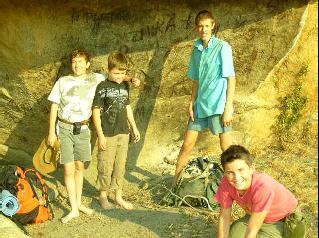 Under an overhang of a large boulder, we found some Bushmen paintings. |
We had an early start to the day. But because it was cold none of us wanted to get out of bed.
Dylan made a small fire whilst we ate our hot breakfast. Having had breakfast, we packed our kit,
had a final mug of coffee and then continued on the trail again.
We followed a footpath, one of many, as we were now in
the Communal Land. Our fist stop was at a small cluster
of large boulders. Under one overhang we found some
Bushmen paintings and also a grinding rock used to
grind millet seeds. We also found some pieces of a clay
pot.
Continuing on our hike, we saw the spoor of a small cat
and later a duiker ran across in front of us. On coming
out of the trees we saw Shumba Shaba in front of us.
We were nearly at the end of our hike and as it was still
early, we decided to climb Shumba from the eastern
side, a direction we do not usually climb from. At the top
we had a rest. This was Dylan's first time to have
climbed Shumba and what is more, with his back pack. Dylan has not yet been invested into the
Troop and he has already taken part in two hikes.
On coming down from Shumba, we followed the main road back to Gordon Park. On entering the
Park, we found the spoor of a tortoise and later when we went for our showers in the camping
area, we saw five Kudu, one being a calf. Our thirteen kilometre hike over, we had an early lunch.
Declan FitzPatrick and Dylan Strydom
Troop Camp
17th - 19th October 2008
Remember the mid-term exeat weekend? We all looked forward to the break from school and in
those days they were of four days duration, but somehow they have shrunk to only three days.
This term the exeat weekend coincided with the annual Jamboree-On-The-Air event, but sadly
Matabeleland could not take part in this international event as we could not find a local amateur
radio operator to run a station for us. Equally disappointingly, we could not find anyone to host the
Jamboree-On-The-Internet event for us. It is sad how our Scouting activities have contracted,
when the rest of the Scouting world are able to take advantage of old and new technology to
communicate with one another.
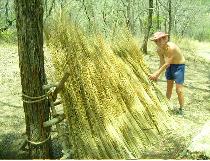 Brendan constructing a bivi out of natural materials |
Although no official camp had been planned by our
Provincial Leaders, members of the Troop opted to go
camping to make the most of the long weekend. We set up
camp in our campsite early Friday morning and generally
busied ourselves until lunch time. In the afternoon we
managed some instruction in our Scouting skills.
Bright and early on Saturday morning saw us standing on
the top of Shumba shaba, where Daniel did his, 'setting a
map using natural features' test. He then checked its
orientation with a compass. Having done his test, we all
scarpered down the kopje to prepare and have breakfast
back in camp. The rest of the day was spent on scouting
activities that we can not do at our Troop meetings, as we do not have the equipment available or
the time during an evening. Following dinner, we decided to sleep on the kopje behind our
campsite as on many occasions we threaten to do so, but somehow we just don't. It was a
fantastic evening with a clear black sky studded with millions of stars. The early dawn and sun
rise were equally spectacular.
As we had spent the night on the top of a kopje, we didn't climb Shumba on Sunday morning.
Instead we had our breakfast and then continued with our instruction and test passing for most of
the morning. In the afternoon we went exploring until it was time to go back home.
We thoroughly enjoyed ourselves.
Chris, Daniel, Brendan, Dale, Dylan and Norman
The Troop in Camp
Celebrating a Century of Scouting
In 2009 the Troop will have been operating for One Hundred years. Former members are invited
to write a brief article for Pioneer Trail of their experiences in the Troop.
An Historic Ramble
7th - 8th November 2008
November is not the best month as far as the monthly Troop hike is concerned, as our Scouts are
writing their end of year examinations and therefore parents are not too keen on letting their sons
wander off on hiking forays. Never-the-less, the Troop programme is also an important part of life,
especially in the 1st, and although we sometimes change a date or two, or add in an extra activity
for good measure, we have not yet had to cancel a monthly hike.
November this year was rather an important month, Leon, a former Patrol Leader in the Troop
and holder of the Sable Award, returned home from England for just one week and the hike
weekend happened to fall during the time he was here. So the hike went ahead as planned with
Leon, Dale and I exploring new territory; the present members of the Troop had not yet visited.
At the eleventh hour, I asked Ian Harmer, a good friend of the Troop, if he could assist us in
getting us to our starting point of the hike, as not having a second vehicle to take us so far from
our finishing point, would have made life rather difficult for us. I was thus able to leave Inguluvane
at Gordon Park, where we were to end our hike. Ian took us to the headwaters of the Tuli River,
not far from the site of Fort Usher. Now if you know your Scouting history, you will know that our
Founder, Lord Baden-Powell had been in the army before he started the Scout Movement. During
his military career, he had been involved in the hostilities of 1896 in Matabeleland, in particular
the Matobo Hills. One of his tasks was to locate a site and construct a fort. This he duly did in
1896 and named it Fort Usher No. 3. Mr. Usher was a trader in the area at the time. As we had
been to Fort Usher during other hikes we had undertaken and it was now dusk and we had some
way to go, we did not stop here.
It was dark by the time Ian dropped us off at our night camp next to a small dam close to the
headwaters of the Tuli River. The Tuli River is one of only three rivers that has its headwaters in
the Matobo hills and flows directly into the 'Great, Grey, Green, Greasy Limpopo River', which
river, forms Zimbabwe's southern border with South Africa. Not far from where we camped, it
forms the eastern boundary of the Matobo National Park. The other rivers rising in the region of
the Matobo hills and, which flow directly into the Limpopo, are the Simukwe in the west and the
Umzingwani in the east.
The half moon was obscured by threatening rain clouds and the only light we benefited from was
the flashes of lightening, which thankfully were not too close. However, as a precaution, we
erected a trail sheet to afford us some shelter if it did rain.
 Dale and Leon have breakfast "in bed" |
We were lucky, it did not rain
The first light of dawn was at 4.30 a.m., not that we got up,
I for one just rolled over for another hour before getting out
the cooker to boil water for an early morning mug of
coffee. It was still overcast when we heaved our ruck
sacks onto our backs and headed in a southerly direction
following the Tuli River.
Passing a number of villages, we waved cheery greetings
to the local inhabitants, who were rather perplexed at
seeing hikers out so early. It did not take us long to reach
an area that had been the scene of a battle in 1896 in
which, Baden-Powell was involved. The area of the battle
is now partially flooded by a small dam built in the mid
1980's, to provide water for the rural population. A few early morning fishermen warmly greeted
us. The dam wall is built on the edge of a waterfall of about five metres and it is at this point that
B-P recorded the following in his book 'The Matabele Campaign' 'Having crossed the marshy
river bed of the Tuli, the men rushed up the smooth domed granite kopje after the enemy'.
Our next stop was about one and a half kilometres further south, but higher up from the Tuli River
and concealed in amongst the rugged kopjes. Here we located the remains of foundations of King
Lobengula's 'Kantoor' or office. This had been a building built by a fellow named Johnny Halyet.
He had moulded and burnt bricks to construct a small 'office' for the King of the Matabele. Mr.
Halyet had also built a 'Palace' for King Lobengula at the royal kraal situated at Old Bulawayo
some twenty kilometres to the north. The Matabele did not make bricks to build their houses, but
instead used poles cut from trees and then by placing them close together upright in the ground
and plastering them with mud, would form the walls. The roofs were thatched with grass cut from
the veldt.
Having had our historę lesson, we headed in a westerly direction at a brisk pace for our next stop
of interest close to Shumba shaba. Some time ago, Brendan, Dale and I had decided to try and
locate a cave that we had heard about in the vicinity of Shumba shaba and after about an hour of
searching in a kopje that we were told it was in, we found it.
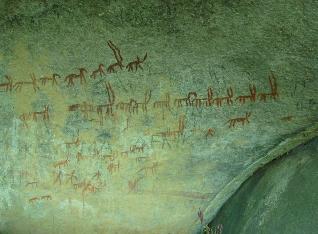 The strange paintings in Mavavani Cave. Possibly late iron age. |
This hike proved an ideal time to
show Leon the cave, for it was in the kopje he had chosen,
as 'His' kopje. Further, we had been told that the kopje's
name was Mavavani and so now we had a name for the
cave and Leon's kopje. The cave contains a good number
of paintings, but not of the usual Bushmen style. On
making enquiries of their origin, it appears that they are of
the Iron age, which followed the Stone age when the
Bushmen first occupied the hills until about 800 years ago
when they were displaced by the influx of the Bantu.
Naturally, Leon was elated that 'His' kopje contained a
cave which, had paintings.
Our hike ended at Gordon Park. We had covered twentythree
kilometres, visited areas of the Matopos where Baden-Powell had been scouting one
hundred and twelve years ago. We had admired the rock art of the Bushmen who had inhabited
the hills from as long as sixty thousand years ago and had met the local people going about their
daily lives.
Norman
Chimanimani Hike 2008
8th - 13th December 2008
Chimanimani. Well, as it is a Shona word it should really be spelt, 'T'Shimanimani' and means,
'squeezed together'. Strictly speaking the name refers only to the narrow gorge where the
Musafa River flows through the mountain range. But, time and the mixing of different peoples with
their cultures, languages, pronunciation of words and misunderstandings, tend to modify names.
Today we know the mountains as the Chimanimani and that is where, we as a Troop have been
going, at the end of each year for a hike. Not only is it a hike, but it is a mini expedition for we
have to travel by car for 560 kilometres, by the most direct route, to reach the mountains, which
are to the east of Bulawayo and are situated on Zimbabwe's eastern border, with Mozambique.
 Norman, Declan, Brendan, Dillin, Christopher and Dale |
Now our intrepid Scout Leader has never learnt to
drive directly to any destination. No, he must always
add some thing extra to any activity and so although
we left Woodlands Service Station, it made a change
from our usual meeting place, at 06.00hours on
Monday 8 December, we did not reach Chimanimani
until the next day. Places of interest along our zig
zagging journey were, Chivi, a one horse rural
settlement; Ngundu Halt, blink and one would miss it;
Triangle, the centre of our sugar industry and very
noticeable as it is many hundreds of hectares of lush
green in a very dry area. Continuing eastwards we
crossed the mighty Savi River over the Jack Quinton
Bridge, at an altitude of 375 metres. It was to be the lowest point of our journey. This is the
longest concrete bridge in the country and we know it to be true, as us Scouts were invited, nay,
ordered to walk across it and watched in disbelief as our transport diminished to the size of a
small dot by the time it reached the other end of the bridge. There was not much water in the river
and many of the inhabitants of the area were in the river netting fish.
Having crossed the River, the road we were following turned northwards. Nearing a range of
mountains, we turned off the main tar highway and followed a rough dirt road. This road wound its
way through gorges and around demolished bridges as we followed the border with Mozambique,
gaining altitude as we went. After what seemed like an eternity and shrouded in dense clouds of
fine red dust we found ourselves on a narrow tar road heading into the dark Chirinda forest atop
Mount Selinda. At an altitude of 1100 metres, this forest is fed by the incoming moist air masses
coming from the Indian Ocean across the Mozambican flat lowlands. It is the only sub tropical
forest in Zimbabwe and contains many unique plants and animals. We headed straight for the
campsite deep in the forest, where we spent a most memorable evening under the canopy of
gigantic trees.
Early Tuesday morning we headed for the 'Big Tree', a Khaya nyasica. (now Khaya anthotheca)
This tree is estimated to be between 1500 and 2000 years old. Its height is 65 metres and the
buttressed base measures 4.5 metres in diameter. Leaving the forest we now headed for the
Chimanimani Mountains stopping on the way at Thomas Moodie's grave. Moodie was the Leader
of the first white settlers to trek to the area, reaching the grassy uplands of Gazaland, as the area
was then known, on 3 January 1893.
Our journey to the mountains ended in the car park of the 17 110 hectare Chimanimani National
Park at 10.15 hours on Tuesday morning, having travelled 760 kilometres from Bulawayo. (What
happened to the 560 Kilometres it should have been?) Norman booked us in, telling us as we set
off on our hike that there was not another person in the mountains. The whole Park was ours and
so it was for the duration of our hike, as nobody else had booked in from the time we had left the
car park until the time we returned.
The sun was high and the morning already hot as we set off for Banana Grove, the easiest route
up into the mountains. Chris, who had already been on three previous hikes in the mountains
took the lead, with the rest of us excited hikers following close behind. One observation we all
made, was that there had not been very much rain as many of the steams which should have
been flowing, were dry. We only stopped once before reaching the top of the initial climb. Here, at
the top, we had our first peek into the mountains behind the 'curtains' that of the soaring rugged
features of 'Turret Towers', 'The Airfield' and 'The Saddle' away to the south east.
It was exhilarating. It was vibrant. It was the Chimanimani. It was what we had come all this way
to enjoy, to soak up, to live with for the next few days. Having had a rest we headed along the
well worn trail that wound in between the trees, the open grassland fields of the rolling hillsides,
ever lower and lower down to the Bundi River, the main river in the mountains on the
Zimbabwean side of the massive ranges of uplifted folded quartzite. On reaching the Bundi River,
we were surprised at how little water it contained for this time of the year, our rainy season but,
there was plenty in the vast pools. Chris, Declan, Dale and Dillin had a swim, while Brendan and
Norman continued on to Terry's Cave, our intended night stop. Tea was most definitely on their
minds, not swimming.
As night drew in, the aroma of cooking food filled the evening air, Mmmm, food fit for hungry
young men and well deserved, for the climb had been tough going. Before turning in for the night,
we went down to the stream for a wash, only one hundred metres away. A rising moon lit the
silent hills across from our cave. The world was at peace and so we slept.
We awoke early, it was only 04.00hours, but it was already quite light. Working in pairs, we made
our breakfasts, packed our kit and were hiking by 06.30 hours. The morning air was fresh and not
a cloud in the sky. Chris once again led us, this time at a faster pace for we were heading for a
small waterfall further upstream on the Bundi.
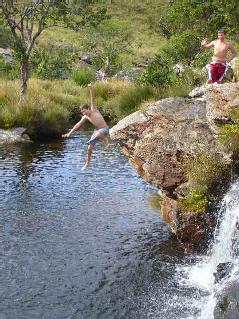 One by one we all jumped over the edge of the waterfall |
In no time we had
covered the four or so kilometres. By now, the sun had edged over
the top of Turret Towers bathing the waterfall in its warm light. We
stripped down and one by one hurled ourselves over the edge of the
waterfall to splash eagerly into the deep clear pool eight metres
below. Laughter filled the air, along with shouts of 'You can do it'
from those who had jumped first, to those of us who had hesitated.
Knowing that there were more waterfalls to play in further upstream,
we didn't stay too long. Shouldering our ruck sacks, we crossed the
river onto the right hand bank and continued on our way to
Peterhouse Cave. Once at the cave, Chris set about looking for the
notes that Paul and Jonathan had hidden in cracks in the wall of the
cave on a previous hike. Finding Paul's note, Chris read it. 'Paul
Carlsson, 4 January 2004' Wow! That was four years ago. Carefully,
Chris refolded Paul's note and placed it back in its hiding place. We
never found Jonathan's.
Our next stop was at the Bundi Falls. These falls cascade down the
steeply angled face of the rock into a large clear pool. Once again
we all had a swim with all the Scouts jumping off rocks that poked their heads above the surface
of the pool. We were all excited and as it was still early, only 11.00 hours, Norm decided that we
should climb Binga (Kweza) the highest mountain in the Chimanimani that afternoon and not to
wait until the next day in the event that it would be covered by cloud in the morning. So, donning
our ruck sacks, we headed off along a little used path that led us in an easterly direction and then
north up out of the Bundi valley and onto the footpath leading from the Mountain Hut to Binga. At
12.00 noon, a halt was called at the foot of a steep climb leading to Hidden Valley in front of
Binga. Here we had our lunch, hid our ruck sacks and continued up a very steep incline to Hidden
Valley.
On reaching the top of this climb we were confronted by the Binga Massive. Boy, what a sight. On
we trekked round the edge of Hidden Valley until finally we started on the accent of Binga its self.
It was 13.50 hours when we found ourselves standing next to the border beacon on the very top
of Binga at 2440 metres. On one side we were in Zimbabwe, on the other we were in
Mozambique. We had climbed 1256 metres since leaving the Park's office and were now at the
highest altitude of our expedition/hike. From the bridge across the Save at 375 metres to this
point we had driven/ climbed 2065 metres. We had our snack of trail mix and then started down
the mountain to collect our ruck sacks before heading for the Mountain Hut for our final night in
the mountains. It was 17.30 when we reached the Mountain Hut. Here, we made our supper and
then spreading our ground sheets and sleeping bags out on the grass in front of the hut we slept
soundly until 05.00 hours the next morning.
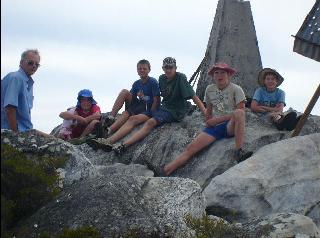 Resting on the top of Binga at 2440 metres above sea level |
Once again we made an early start, this time heading
down out of the mountains via Bailey's Folley, a very
steep descent, which brought us out at the Park's
office and where we had left Ingulungundu, Norm's
long wheel base Land Rover. Norm reported in at the
office to let them know of our safe return and then we
piled into Ingulungundu and headed for the Outward
Bound Mountain School some five kilometres away.
Arriving at Outward Bound, Norm asked for
permission for us to go to Tessa's pool for a swim
while he refuelled the vehicle before joining us in our
last swim in the Chimanimani Mountains for this year.
Our next stop was at the National Park's Headquarters
in the village of Chimanimani, where we were given
permission to visit Bridalveil Falls in the Eland Sanctuary some eight kilometres out of the village.
These falls were really spectacular and the pool at the bottom extremely cold. Not all of us had a
swim.
Norm announced that as we had come down the mountain so early in the day, we now had time
to make a 'small' detour on our return journey to Bulawayo and would therefore, go to Mutare to
visit an old friend of the Troop, Mr Ken Nortje. So we headed for Mutare, arriving there just after
17.000 hours. We spent a pleasant evening with Ken and then early on Friday morning with Ken
as our guide, we went to visit Chinziwa, Manicaland's Provincial Scout Camping Ground in the
Vumba. It is in a sad state of disrepair and overgrown which suggests that it is no longer used by
Scouts. Thanking Ken for allowing us to camp in his garden for the night, we bid him farewell and
headed for Birchenough Bridge, 130 kilometres south of Mutare. Our 'small' detour amounted
to an extra 194 kilometres but, it was worth it, as some of us had never been to Mutare before.
Arriving at Birchenough Bridge, we disembarked from Ingulungundu and walked over the bridge,
while Norm drove to the other end to wait for us. The bridge is a steel structure resembling the
Sydney Harbour Bridge in Australia, in fact the ropes on which the bridge deck is suspended
were used during the construction of the Sydney Harbour bridge. Both bridges were designed by
the same engineer, Sir Ralph Freeman. The Bridge was named after Sir Henry Birchenough
whose ashes lie within one of the pillars of the bridge. Back in the vehicle, we had an uneventful
journey all the way to Lake Mutirikwe, where we arrived at 17.00 hours.
Lake Mutirikwe was constructed to be a water supply dam for the irrigation of the sugar cane
estates at Triangle, some 125 kilometres down river. We were lucky to see that the gates had
been opened, letting millions of cubic metres of water cascade down the river to the estates.
Having looked around the dam wall and the tiny twelve seat chapel built high up on a granite
kopje overlooking the lake by a former water bailiff for his daughter's wedding, which sadly was
not to be, for she was tragically killed in a motor car accident before her wedding, we continued to
our campsite for the night.
By prior arrangement, we had been given permission to camp in the grounds of the Hotel, 'Inn on
Great Zimbabwe' a three star rated establishment. We made ourselves comfortable in a pavilion
over looking lush gardens and not too far distant, the waters of the lake. At 19.00 hours, smartly
dressed in our Scout uniforms, we entered the hotel for sundowners to be followed by a four
course dinner. It was most certainly the best meal we had had on our expedition.
Saturday morning dawned bright and sunny. Having had an early breakfast, we left on our final
journey home, stopping off at the Italian Chapel just outside the town of Masvingo, to admire the
paintings on the walls and ceiling. Then off we sped only to stop briefly to look at the Kongesi
ruins and a stop further down the road at a farm to drop off a parcel that Norm should have
delivered the previous December, following last year's trip to the Chimanimani Mountains. We
arrived back in Bulawayo at 14.30 hours to a warm welcome and relief of our parents.
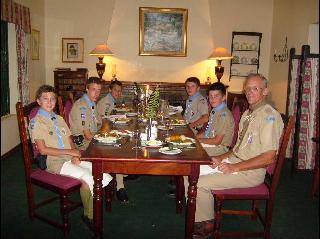 Our end of expedition Banquet at the "Inn on Great Zimbabwe" |
Our expedition/hike was over. In all we had travelled
1674 kilometres in Ingulungundu and we had hiked 40
kilometres with an altitude change of 1256 metres.
The weather had been fantastic, sunny with clear blue
skies in the mornings and bulbous cumulus cloud
building up in the afternoons. It had been warm the
whole week with no rain. The evenings were bathed in
brilliant moon light with a full moon on the Friday night
when we were at Lake Mutirikwe. Moonrise across the
lake was awesome.
Our expedition had begun with a bible reading and a
prayer for us by a parent on our departure at
Woodlands Service Station on Monday 8 December
and we ended off on Sunday 14 December, with a
Thanks Giving Service for a fantastic experience and our safe return, in the St. George's Chapel,
Gordon Park.
We thank our parents for affording us this opportunity and those who sponsored the fuel for the
expedition.
Christopher MacKenzie, Dale van Aarde, Brendan Judge, Declan FitzPatrick, Dillin McAtier and Norm
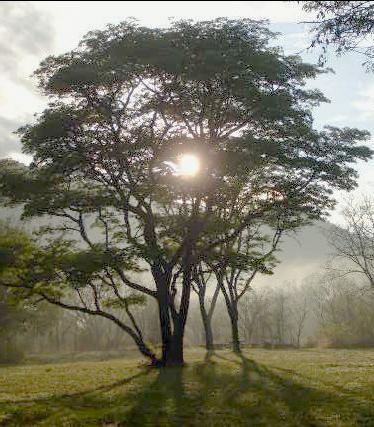 |
....you must always think well of yourself and
realize your own worth.
You are a pearl of great value.
Don't ever forget those things, especially in your
darkest moments.
Teena
for January - April 2009
'Celebrating One Hundred Years of Scouting' 1909 - 2009
Troop Programme of Activities for:-
January
1 New Year's day
9 - 10 Monthly Hike
11 Gordon Park Service: 12.00 noon
13 Schools open
16 Troop meeting
23 Troop meeting
24 Provincial sports Day
30 Troop meeting
February
6 - 7 Monthly Hike
7 - 8 Parent's camp
8 Gordon Park Service: 12.00 noon
13 Troop meeting
20 - 22 Baden-Powell Camp: Gordon Park
22 Baden-Powell Day service: Gordon Park: 12.00 noon
27 Troop meeting
March
6 -7 Monthly Hike
8 Gordon Park Service: 12.00 noon
13 Troop meeting
13 Africa Scout Day
20 Troop meeting
27 Troop meeting: Sausage sizzle
28 Provincial Swimming Gala
April
3 -4 Monthly Hike
9 Schools close
10 - 13 Easter
12 Gordon Park Service: 12.00 noon
15 -18 Troop 'One Hundredth Anniversary' Expedition
18 Zimbabwe Independence Day
24 Troop meeting
26 Provincial St. George's Day Service
Additional Activities may be added to the Programme